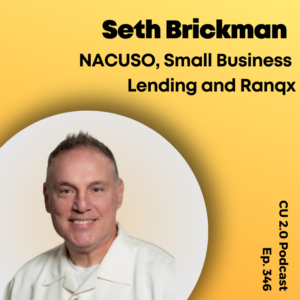Although most Americans say they’d prefer to invest through their financial institution, less than 0.5% of credit union members do.
Most members invest outside of the credit union. They have 401ks and IRAs from employers. They have wealth managers and brokers. And, more commonly, they invest on their own, thanks to fintechs.
Of course, members invest with their credit unions as well… but not nearly as much as they could.
In this blog, we’ll discuss the world of fintech investing, credit union investment services, and Eko. Spoiler alert: we strongly recommend learning more about Eko.
Why Credit Unions Must Provide Investment Services
Typically, we introduce a problem using trends and data. But this time, we’ll use anecdotes and invite you to investigate the trends and data for yourself—you have member data that tells a better story than any national poll.
To begin, many/most of the CU 2.0 team has a minimum of 2 investment apps. More if you count crypto wallets (a sore subject right now, to be sure) and PayPal/Venmo.
And, while our investment strategies differ, I personally shunt about $1,000 each month away from my bank and CU and toward these apps. Chase sees the transfers and reminds me to invest with them, but my CU hasn’t caught on yet.
Given that we’re young-ish and far from the most aggressive investors out there, and given that investment apps have grown considerably more popular and sophisticated in the last 5 years, it’s logical to assume that credit unions are losing a tidy sum of deposit and investment money each month.
Don’t believe me, though. Check your data. See how much your members send to one of the investment apps or robo-advisors below each month.
But if you’re checking stats, here’s one thing you can only check after offering a digital investment product: on average, members log in 3x more often if they hold an investment with you. So, if you want to boost member engagement, look no further.
The Most Popular Digital Investment Providers
In case it’s not clear who the competition is, we’ll list them here. We’ll also list potential partners. This list is far from comprehensive, but it should paint a clear picture of the landscape and what’s at stake.
We’ll also define some key terms to differentiate between how each company operates:
Robo-advisors are digital investment platforms that automatically allocate, balance, and manage money without directly involving a financial advisor. They’re typically cheap, especially considering their available features, and many offer personalized services.
Digital brokerages and investment apps are platforms that allow users to buy, sell, and manage stocks, ETFs, bonds, cryptocurrencies, and more. You could also call this “self-directed investing. Some of these options are geared toward beginners, while others cater to more experienced investors.
Wealth management firms are more traditional, but may feature investor dashboards, apps, or other ways to manage money digitally. For the most part, we’ll leave these out, with a few exceptions to make a point.
1. Acorns
Competitor. Acorns is a robo-advisor that rounds up spare change from purchases and invests it in a risk-appropriate portfolio. They now offer IRAs, checking accounts, and UGMA/UTMA accounts as well.
1. BestVest Investments, LLC
Vendor. BestVest Investments helps credit unions implement a member financial services solutions with a massive array of investment and insurance options, but their digital offering isn’t as clean or convenient (read: sophisticated) as most competitors on this list.
2. Betterment
Competitor. Betterment is a robo-advisor with good customization options and goal-based tools. And, because there’s no account minimum, it’s easy for anyone to get started.
3. CUSO Financial Services
Vendor. CUSO Financial Services and Sorrento Pacific Financial work with credit unions and banks to improve their investment services and modernize with digital offerings.
4. Eko
Partner/vendor. Eko is a robo-advisor and digital investment platform that allows credit unions to offer balanced, customizable, and competitive portfolios through their existing online and mobile banking.
5. E*TRADE
Competitor. Morgan Stanley (further down this list) didn’t want to miss out on small-time digital investors, and it purchased E*TRADE to cater to digital-first investors with a variety of stocks, bonds, and more.
6. Morgan Stanley
Competitor. Morgan Stanley is a traditional wealth management provider with a wide variety of wealth building and management options, with emphasis on individual and in-person financial advisory.
7. Robinhood
Competitor. Robinhood is a digital brokerage and investment app that pioneered free trades and a simple user interface. Users can purchase fractions of stock, buy and send crypto, and create a spending account with rewards.
8. SoFi
Competitor. SoFi is a robo-advisor now because of course they are—what aren’t they doing? Although they feature only a few automated investing options, SoFi will probably expand quickly.
9. Unifimoney
Partner/vendor. Unifimoney offers both a robo-advisor and digital investment platform that also offers digital asset trading (yep, crypto) through their financial services-friendly platform.
10. Vanguard
Competitor. Vanguard is a robo-advisor with relatively few portfolio options and limited customizability, but their expertise and track record are top notch, and most providers on this list rely at least in part on Vanguard’s ETFs.
11. Wealthfront
Competitor. Wealthfront is a robo-advisor that rebalances and does tax-loss harvesting daily, thus optimizing portfolios better and more often than most robo-advisors.
12. Webull
Competitor. Webull is a digital brokerage and investment app that provides a similar experience to Robinhood, but with more sophisticated options that support intermediate and advanced traders better.
This list could easily include others like Gemini, TD Ameritrade, Merrill, Charles Schwab, Fidelity, UBS, Ally Invest, and more. These providers are, by and large, competitors with far more assets under management than most or all credit unions.
Often, these providers are the first place that members look for investing and wealth management.
In part, that’s because credit union investing is branch-first, not digital-first. Even credit union partner/vendor options lag behind the competition when it comes to digital delivery.
That’s why we need to introduce Eko.
Introducing Eko
Eko enables credit unions to offer digital investing, directly on their existing banking platform via their white-label solution. Emphasis on digital. Honorable mention to white-label.
A few months ago, we met with Eko CEO Mart Vos to explore his platform. It ticked the boxes we knew credit unions would care about:
- It meets a product need that credit unions need to provide—especially to attract younger members;
- It increases deposits—investments can be funded through 3rd party FIs, but deposits go into your CU;
- It improves engagement, leading users to 3x more logins than non-investing members;
- It’s white label, keeping the credit union brand up front;
- It improves credit union income with new product opportunities;
- It integrates directly with existing digital banking platforms;
- It only costs money if it make money; and
- It deepens the relationship between members and the credit union.
That’s what we needed to know to consider it a viable solution for credit unions. But we don’t write about or work with every fintech that’s viable.
We got excited.
It ticked the boxes that might not immediately matter to credit unions, but which do matter to consumers like us. Which, to call back to the beginning of this blog, we at CU 2.0 and sending thousands of dollars per month to competing investment solutions.
We all agreed, we’d use Eko if we could.
Eko is a hybrid between a robo-advisor and a digital brokerage. The robo-advisor recommends a safe, suitable, set-it and forget-it portfolio, but it allows for self-directed investing. It’s like Acorns and Robinhood had a baby and then let a credit union raise it.
And Eko’s profiles are really, really flexible. They include the usual scale from low- to high-risk, plus options to focus on specific industries. And, although it’s not exactly emphasized in the platform, you may choose investment portfolios that favor green energy, socially responsible companies, regional companies, and more.
Here’s the kicker, though:
When a credit union works with Eko, all members see their investment account balance alongside their other account balances in their online or mobile banking dashboard. Yes, even if they haven’t set up investing and have $0 in it.
If that’s not a prompt to start, I don’t know what is. From there, thanks to a negligible minimum investment and easy onboarding, any member set up an investing account quickly and easily with their credit union.
This is a product that credit unions need. Members already want it and use products like it, after all!
Additional Resources
Like what you’ve seen so far? Sign up for our Fintech Call Program and get a personalized, 30-minute call each quarter. We’ll discuss the latest technologies and solutions, make key introductions, and offer early access to events, giveaways, and more!
And of course, please subscribe to our blog (if you haven’t already)!




